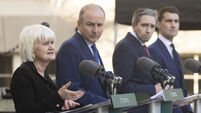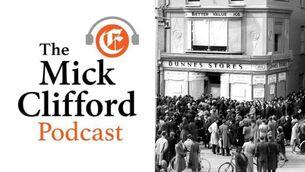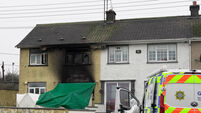Quiet Man speaks to all of us
THERE seems to be no silencing The Quiet Man. The 1952 film about a returning Irish emigrant, his courtship of a local woman and their feisty marital relationship continues to provoke discussion, documentary and revision.
The Quiet Man will be discussed at the forthcoming Maureen O’Hara Classic Film Festival, which is in its third year in Glengarriff. The festival will not focus solely on The Quiet Man — nor is it limited to the work of actress O’Hara alone.
O’Hara made 56 movies and a selection of them will be shown during the week, including Jamaica Inn, How Green Was My Valley, The Black Swan and The Parent Trap.
In addition, three daughters of Hollywood are joining her this year in a celebration of their fathers’ work, both with O’Hara and on other productions.
A screening of The King and I will be introduced by Patricia Shamroy-Shaw, whose father Leon Shamroy was cinematographer for the movie. Shamroy also worked on The Black Swan, for which he received an Oscar — one of four. Rory Flynn, daughter of actor Errol Flynn, will introduce her father’s movie The Adventures of Robin Hood. Susan Bernard, daughter of photographer Bruno Bernard, will introduce Some Like it Hot, with a talk on her father’s work with Marilyn Monroe and other stars of the era.
But it is The Quiet Man that still plays on the Irish psyche. At the time of its release, some said it portrayed the Irish negatively; some still see it as stereotype. Roddy Doyle ‘took on’ the late director, Irish-American John Ford, in the third part of his Henry Smart trilogy of novels, The Dead Republic, which was published last year.
In Doyle’s book, Ford discovers Smart, who has had a violent past in the War of Independence and the Civil War, and gives him a job on the film crew as a consultant, muse and writer.
Ford wants to hear Smart’s experiences so as to make the film as authentic as possible, but in the end he gives way to the demands of Hollywood entertainment. Doyle couldn’t say it any clearer: this is not how it was.
In truth, Ford was keen on a greater IRA involvement in the movie when he first dreamed it up. He had returned to Ireland in 1921 and saw the home of his cousins, the Thorntons, burnt out by the Black and Tans. However, his own experiences as a documentary maker in World War 2 softened his enthusiasm for highlighting the violence and he kept the script close to Maurice Walsh’s original short story of the same name — although he did have a consultant on set in the person of former IRA man Ernie O’Malley.
Another Doyle — filmmaker Sé Merry Doyle — is also looking deeper into this film with his documentary Dreaming the Quiet Man, which he will present at the festival. He likes what he sees in the movie and empathises with Ford. He gathers some notable contributors, including director Martin Scorsese, who peel back the layers of drama and find considerable substance in the film.
“I used to hear people describe it as ‘a load of tosh’ but it had John Ford involved so I knew it couldn’t be,” says Doyle, explaining his reasoning for the documentary. “Ford had become disillusioned with American consumerism and wanted to create a simpler place, a less hectic place and this was Inisfree. It caused some discomfort to some Irish people at the time, because they were trying to drag themselves out of that into a new country. I think it’s a generational thing. Students today have no problem with it.”
The film will be introduced at the festival by American screenwriter Tom Richards, who also looks beyond the stage Irishness. “I don’t think it was trite and I don’t think it was stereotypical,” says Richards, who now lives in west Cork and is doing a PhD on film at NUI Maynooth. “I think John Ford had to use some elements that were stereotypical for the market but I think it’s a film with big dramatic questions. It reflected some of what Éamon de Valera thought about Ireland and Ford created solid individuals battling against the social elements.”
Richards draws comparisons with Man of Aran, where the protagonists are battling natural elements. He will deliver a screenwriting workshop at the festival, using The Quiet Man’s classic Hollywood structure of three acts to show what was achieved.
Work is due to begin in August on Connemara Days, a film based on the set of The Quiet Man and telling a local story of a young girl who falls in love with one of Ford’s assistant directors. It was written by Englishman Steve Mayhew, who has no Irish connections, but is a devotee of the work of John Ford and a big fan of John Wayne. He is completing a PhD on Ford’s silent movies. Mayhew visited Cong in 1993 and, although he had been considering writing a screenplay based on Ford’s time in Monument Valley — where Ford filmed many of his westerns — and the Navajo Indians who live there, he found his angle in Cong instead.
“I just thought, what would it have been like to be a kid in Cong in the ‘50s and walk out your door to see John Wayne in front of you,” says Mayhew. He describes The Quiet Man as a comedy, a Hollywood version of Ireland that is only short of a leprechaun.
“Some people see it as a musical. It is a wishful version of Ireland for Ford and it is full of Irish character. In some ways, it is quite critical of Ireland in terms of the traditions and I imagine if you were a feminist you would cringe at parts of it. There are a lot of themes that are quite serious. Remember, we are looking at it now through contemporary eyes,” he says.
Almost 60 years on, we are most certainly looking at this story with different eyes. The point appears to be that Ford has left us with plenty to look at and chew over. Something about it is still scratching at the consciousness, which is why The Quiet Man is still making noise.
The Maureen O’Hara Classic Film Festival takes place from June 17 to June 26. www.maureenoharafoundation.com/mohcff
By Rory Flynn
Errol Flynn’s daughter Rory began modelling with the Eileen Ford Agency and worked with so many top photographers that she eventually took up the camera herself. She became a stills photographer for film and TV sets and has worked on more than 35 feature films. She wrote a book entitled The Baron of Mulholland about growing up as the daughter of a famous Hollywood actor and, as a result, has developed a lecturing career.
Patricia Shamroy-Shaw’s father was the cinematographer Leon Shamroy who won four Oscars for his work (including one for Black Swan starring Maureen O’Hara and Tyrone Power). Pat never wanted to be part of the movie business, but she worked as a TV news researcher before switching to photography. Her solo exhibition American Women in Politics is now held in the permanent collection of Harvard University.
Susan Bernard’s father Leon Bernard was a noted photographer of Hollywood stars, the man responsible for many portraits with which we are familiar and otherwise known as Bernard of Hollywood. Susan began as an actress at the age of 16 and starred alongside Orson Welles and Henry Fonda. She has collaborated on many film and theatre projects and has authored seven published books, including books of her father’s photographs.
















